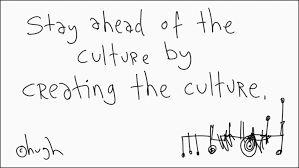Chapter two of Management Basics for Information Professionals by Evans and Alire (2013) examines the ways in which an organization’s environment influences behavior. I noticed a pervading trend within the chapter’s discussion of libraries as organization, and that trend is that all environments are retained within a hierarchal structure based around the external and parent environments. I can certainly see how a public or educational library could be considered as ‘placid-clustered’ in terms of it adopting long term goals with some short term objectives that are determined by environmental factors. However, I can also see how this kind of structure may well be limiting within a library also. Long term goals tend to be quite rigid and strict and I think there is a danger of suppressing innovation in so far as the manager is rigidly focused on the pre-established long term goals. In times of a funding lull, this may well mean that a long term project may need to be paused. An example of the negative impact that this strategy can have was given by Katherine McSharry of National Library when she spoke to our class about pausing the digitization project of photographs in Ireland. There is always the danger in an ever-diversifying information age, that long term goals blind organizations to more innovative opportunities.
I say this in agreement with Childs and the anti-environmental argument. It seems to me that a major flaw in many organizations is that they see themselves as subordinate to the ‘whole’, or parent/ external organization. However, there is scope within any organization to influence and shape the whole to the demands and innovations of the organization itself. I think the concept of relevance is important here. The parent organization would like to find ways of operating that are more efficient and effective. Libraries should not wait for the parent company to set the parameters of policy, but should look to find ways to influence the external environment. Companies have often been revolutionized by innovation that has taken place within just one small department.
I think the fact that culture is mentioned in this chapter is interesting. In many ways, there is a defeatist mentality involved in many discussions of culture in which culture is seen as something unchangeable. All too often we throw our hands up in the air and say ‘that’s just the culture!’. There is a sense in this chapter that playing with cultural norms is too dangerous for managers to contemplate, as though all culture is inherently good. I have worked in organizations that have been destroyed by an adherence to negative cultural norms. As someone who has taught English Literature at third level, I am always amazed at the collections of English Literature in university libraries. There are usually hundreds, if not thousands of books gathering dust on the shelves of academic libraries. Many of these books are wasted. Examine the curriculum of UCD’s Department of English in relation to the library’s collection of literary texts. I think 80% of those books will never be read by any students or staff at UCD. But there is a culture within libraries to hang on to and accumulate objects. Maybe many books were donated by a sponsor and the library feels obligated to retain the books on the shelves even if they are not useful? It is useful to ask how much waste exists in our libraries as a result of culture. How could that space be used in ways that are more useful? Could the opening of that space lead to more innovative use of it that might alter the environment (internal & external) for the good of the library and the parent organization? Culture, if seen as a homogenous unwavering influence can be highly destructive to an organization’s development. However, I believe that if it is seen as a heterogenous malleable condition that we can move away from its limiting influence on our learning environments.

